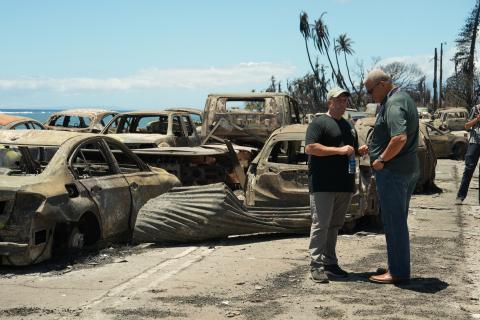Throughout 2017, there were 10 massive storms in a row that became hurricanes, a feat that hasn’t happened since 1893. Though 2017 was filled with some of the more catastrophic storms that the world has ever seen, 2018 has been pretty rough, as well — especially when it comes to vehicle damage.
There are four main causes of auto body damage, including negligence, fender benders, high-speed collisions, and weather. For most U.S. drivers, bad weather might mean heavy snowfall, foggy views, or some strong winds. But during a hurricane, weather can go from bad to horrible in a matter of seconds.
According to the National Highway Traffic Safety Administration (NHTSA), the 2018 hurricane season produce record-breaking and devastating rain and floodwaters, causing thousands of East Coast residents to not be able to access their homes and leaving their vehicles completely destroyed.
The 2018 storm season isn’t even over yet, and already approximately 1 million family and company automobiles have been damaged or destroyed by hurricanes. Vehicle owners need to stay in contact with insurance companies and file claims as soon as the damage occurs. It’s important to note, however, since so many vehicle owners are experiencing similar issues, it could take a long time to get auto repair work done, as well as various insurance and car-buying aspects.
According to Auto Week, though Hurricane Florence damaged fewer vehicles than 2017’s Hurricane Harvey, the storm still destroyed roughly 20,000 vehicles.
The most recent storm, however, Hurricane Michael, has ravaged the Florida Panhandle — damaging thousands of individual vehicles and entire dealership lots.
Hurricane Michael has devastated auto dealerships across Florida’s Panhandle with sustained winds of 155 miles per hour. As of mid-October, it’s still too early to even assess the overall damage suffered by vehicle owners and dealerships because of widespread power outages.
In addition to the powerful winds, Hurricane Michael, a Category 4 storm, caused significant flooding across the southeast and shut down major Interstates.
“The biggest challenges right now are survival, limited contact with dealerships, lack of road access and ensuring the safety for dealership employees,” said Ted Smith, president of the Florida Automobile Dealers Association. “To my understanding, there is extensive tree damage from Fort Walton Beach to Pensacola. With hurricanes in Florida, you have to worry about the tornadoes that follow after the hurricane hits because that’s when a lot of the strong wind damages occur.”
Hurricanes often spawn tornadoes, especially in Florida. For example, Hurricane Andrew, the most destructive hurricane to ever hit Florida until Hurricane Irma, spawned 62 tornadoes in the days after the storm hit back in 1992.
In the weeks and months following the storm’s aftermath, people across the East Coast and affected areas of the country will have to begin purchasing new vehicles, but the government is warning everyone to beware of auto scams after any significant storm because many of the flood-ridden cars end up back on the market.
As reports of damage vehicles pile up, the NHTSA is warning consumers to be wary of scammers. The NHTSA’s website stated that scammers will present a false title that won’t signify the actual damage on the vehicle or will have “lost” the title. The NHTSA recommends three basic tests to determine whether or not flood damage occurred:
- Check for rust and corrosion — Look underneath the vehicle for excess damage caused by water.
- Inspect for dirt and grime — Check the interior of the vehicle for mud, watermarks, and water lines in places not immediately visible. Start with the trunk, glove box, and underneath the dashboard.
- Perform the sniff test — Smell the vehicle to determine if mildew is present.



